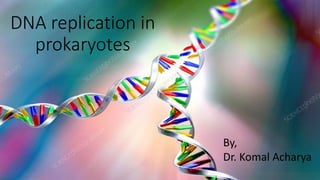
DNA Replication in Prokaryotes Explained
- 1. DNA replication in prokaryotes By, Dr. Komal Acharya
- 2. • DNA replication is a process in which two identical replicas of DNA are produced from one DNA molecule. • DNA replication in procaryotes is, Bidirectional Semiconservative
- 3. • DNA replication in prokaryotes occurs in three steps: 1. Initiation – recognition of the position on a DNA molecule occurs where the replication begins. 2. Elongation – parent DNA strand gets copied at replication fork. 3. Termination – DNA replication process ends. Enzymes/proteins involved in replication process: Process Enzymes/proteins Initiation Dna A, SSB (single stranded binding) proteins, Dna B (helicase), Dna C (helicase loader), Dna G (primase) Elongation DNA polymerases, SSB, DNA gyrase, DNA ligase termination Terminus Binding Protein (Tus), DNA topoisomerase IV.
- 4. 1. initiation: • DNA replication starts at particular site called origin of replication. in E.coli, it is called Ori C. • It spans approx. 245-250 bp of DNA which has two short repeat motifs that includes, 1. 9 bp sequences called as 9-mer repeats that serve as binding site for Dna A protein. 2. 13 bp sequences known as 13-mer. • Replication is initiated when Dna A protein binds to the 9 -mer repeats in Ori C region and forms an initial complex followed by melting of DNA duplex at 13-mer repeats in Ori C. • The separation of double strands of DNA is facilitated by Dna B/ DNA helicase. • Ori C also has 11 5’ GATC 3’ repeats in which adenines are methylated that can initiate the replication. • Ori C is an AT reach region that makes the breakdown of hydrogen bond more easier.
- 5. • This Dna B clamps around each parent strand separated by Dna A. this binding also require Dna C protein which acts as helicase loader. • After binding Dna B moves on the DNA strand in the 5’ to 3’ direction and keep on unwidening the ds DNA. • Reannealing of the separated DNA strands must be stopped for complete replication and that is done by SSBs that bind to both the separated strands. Sequence of events during initiation: 1. Binding of Dna A protein to Ori C region. 2. Loading of DNA helicase. 3. Opening of DNA double helix and binding of primase. 4. Synthesis of RNA primer. 5. Initiation of DNA replication by DNA polymerase.
- 6. DNA polymerases: • They catalyze the synthesis of the DNA in 5’ to 3’ direction. • The DNA polymerases require three things: 1. Template in 3’ to 5’ direction to direct the synthesis of the complementary DNA strand. 2. Primer – small fragments of DNA or RNA 3. dNTPs Enzyme Function DNA polymerase I Remove RNA primer through exonuclease activity and replace it with newly synthesized DNA DNA polymerase II DNA repair DNA polymerase III Adds nucleotides to the growing DNA chain in 5’ to 3’ direction • DNA polymerase III: It is a holoenzyme which has four components, 1.Two copies of catalytic core enzyme 2.Two copies of dimerization component Tau (Ʈ) 3.Two copies of a ring shaped β-clamp 4.One copy of clamp loader called γ-complex
- 7. 2. Elongation • During elongation, DNA polymerases catalyze step by step addition of dinucleotides to the growing strand.
- 8. • The bacterial replication is a bidirectional replication so, two replication moves in opposite directions and at each replication fork there is one leading strand and another one is lagging strand. • Leading strand: strand that is synthesized continuously from a single primer in 5’ to 3’ direction. • Lagging strand: strand that can be synthesized discontinuously in 3’ to 5’ direction as short DNA fragments from multiple primers. These short fragments are known as Okazaki fragments and are joined later on by DNA ligase.
- 9. • DNA polymerase require RNA/DNA primer with a free 3’ OH group annealed to the DNA template. • DNA primase called Dna G synthesizes short RNA fragments as primers on each template. • During elongation, this primase is remained associated with the DNA helicase and this association is called primosome that makes RNA primers which are then extended by DNA pol III. • After formation of Okazaki fragments on lagging strand, RNA primers are removed by DNA pol I. so, gaps are formed in DNA strand that is filled by DNA pol I. These fragments are ligated together by DNA ligase that form phosphodiester bond between 3’ OH group of one fragment and 5’-phosphate group of another fragment. • A topoisomerase enzyme called DNA gyrase introduce negative supercoiling into DNA which has nuclease activity and breaks the phosphodiester bond in a DNA strand.
- 10. 3. Termination • Two replication forks meet at a position opposite to the Ori C region to complete the replication. This position where the replication terminates is known as terminus region. • terminus region has 23 bp Ter sequences which are recognized by sequence specific DNA binding protein called Tus protein (Terminus Utilization Substance). • Tus protein has one permissive end and the other non- permissive end. When the replication fork reaches the permissive end, Tus-Ter complex dissociates and the fork moves further. When the fork reaches at non-permissive end, replication will be terminated. • In E.coli, Ter sequences are oriented such that, both the forks get trapped within a short region and the replication terminates. • after completion of replication, two new identical daughter DNAs are formed which may be interlocked physically that must be separated and that is done be topoisomerase IV.